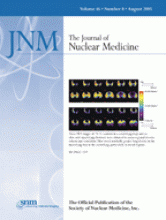Schöder and colleagues review approaches to interpretation of information from the CT portion of PET/CT imaging and preview 2 articles in this month’s JNM that indicate the independent benefits of CT in such procedures.
Bengel discusses the current status of cardiac neuroimaging and the implications of an article in this month’s JNM that provides new information on the relationship between myocardial ischemia and sympathetic nerve integrity.
Welch reviews current research on the potential benefits of α-particles for specific tumor cell killing and previews an article in this month’s JNM that addresses key issues in creating 211At-labeled radiopharmaceuticals for therapeutic applications.

Schaefer and colleagues use cardiac MRI as a reference in evaluating the accuracy of the Emory Cardiac Tool Box in assessing left ventricular end-diastolic or end-systolic volumes and ejection fraction from gated 99mTc-MIBI SPECT.
El Fakhri and colleagues offer an analytic and modeling approach to solving 2 major challenges of 82Rb cardiac PET imaging––accurate noninvasive estimation of input function and absolute quantitation of myocardial perfusion.
Kaufmann and colleagues use PET imaging for in vivo validation of a novel Doppler-based method for calculating coronary volumetric blood flow and coronary flow reserve.

Dunphy and colleagues investigate the utility of PET/CT in examining the relationship of vascular calcification and vascular metabolic activity in the evolution of atheroma.
Giorgetti and colleagues compare 99mTc-tetrofosmin SPECT with contrast-enhanced MRI in the evaluation of myocardial fibrosis in patients with previous myocardial infarction and severe left ventricular dysfunction.
Hacker and colleagues report on a retrospective analysis contrasting the accuracies of multidetector angiography and myocardial perfusion imaging in the detection of hemodynamically relevant lesions of the coronary arteries.

Catafau and colleagues describe normal distribution, specific uptake values, variability, and reliability of the serotonin transporter SPECT ligand 123I-ADAM in healthy individuals.
Forrer and colleagues detail the results of a prospective study of 177Lu-DOTATOC treatment in patients with neuroendocrine tumors relapsed after 90Y-DOTATOC treatment.
Liu and colleagues compare 2 timing protocols for injection of furosemide and radiopharmaceuticals in diuretic renography.

van Westreenen and colleagues report on the rate and clinical relevance of unexpected synchronous primary neoplasms identified on 18F-FDG PET in staging of esophageal cancer.
Lambert and colleagues investigate the feasibility of intraarterial administration of 188Re-HDD/lipiodol as a treatment for hepatocellular carcinoma in patients with moderately advanced cirrhosis.
Beer and colleagues describe the kinetics and biodistribution of 18F-galacto-RGD as a PET tracer for quantification of αvβ3 expression in patients with metastases from melanomas and musculoskeletal sarcomas.
Nestle and colleagues compare gross tumor volumes resulting from 4 methods for definition of radiotherapy target volumes in patients with non–small cell lung cancer.

Bencherif and colleagues examine changes in binding potential of brain μ-opioid receptors as quantified in 11C-carfentanil PET imaging of individuals with bulimia nervosa.
Osman and colleagues assess the incremental added value and frequency of potentially clinically significant incidental findings from expert independent reading of the unenhanced-CT portion of PET/CT studies.
Even-Sapir reviews the basis for detection of malignant bone involvement with various morphologic and scintigraphic imaging modalities and the advantages and limitations of each.

Luisi and colleagues use 11C-hydroxyephedrine PET to investigate whether altered uptake of norepinephrine by sympathetic nerves in viable, dysfunctional myocardium can be imaged in vivo and to assess sympathetic dysinnervation in hibernating myocardium.
Richard and colleagues validate PET measurement of alveolar volume and regional ventilation assessment with inhaled 13N-N2 in a porcine model of acute lung injury.
de Vries and colleagues investigate radiolabeled dopamine D3 antagonist GR218231 as a PET tracer for monitoring P-glycoprotein activity in the blood–brain barrier, a technique with potential applications in drug development and identification of undesirable drug–drug interactions.
Pozzi and Zalutsky report on the effects of radiation dose on synthesis of N-succinimidyl 3-211At-astatobenzoate, a compound used in clinical trials for labeling antibodies with α-particle–emitting 211At.

ON THE COVER
Assessment of regional alveolar volume and ventilation is crucial to understanding the pathophysiology of lung injury. Measurement of 13N-N2 washout using PET has been shown to be accurate in assessing these parameters during experimental acute lung injury. This method can now systematically be used to investigate how the distribution of lung ventilation can be changed by interventions such as positive end-expiratory pressure, prone positioning, or recruitment maneuvers and how these changes may affect ventilator-induced lung injury.







